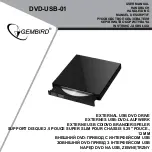
VLT
®
FCM Series
All about FCM
300
Some of the harmonic currents might disturb
communication equipment connected to the same
transformer or cause resonance in connection with
power-factor correction batteries.
To ensure low, harmonic currents, FCM 300
has intermediate circuit coils as standard..
THD (current)
≤
54%
The voltage distortion on the mains supply depends on
the size of the harmonic currents multiplied by the mains
impedance for the frequency in question. The total
voltage distortion THD is calculated on the basis of the
individual voltage harmonics using the following formula:
■
Power factor
The power factor is the relation between I
1
and I
RMS
.
The power factor for 3-phase control
The power factor indicates the extent to which the FC
motor imposes a load on the mains supply.
The lower the power factor, the higher the I
RMS
for the same kW performance.
In addition, a high power factor indicates that the
different harmonic currents are low.
■
What is CE labelling?
The purpose of CE labellingis to avoid technical
obstacles to trade within EFTA and the EU. The
EU has introduced the CE label as a simple way of
showing whether a product complies with the relevant
EU directives. The CE label says nothing about the
specifications or quality of the product. Frequency
converters are regulated by three EU directives:
■
The machinery directive(98/37/EEC)
All machines with critical moving parts are covered
by the machinery directive, which came into force
on 1 January 1995. Since a frequency converter is
largely electrical, and the motor always will be placed in
connection with other machines, it does not fall under
the machinery directive. However, if a FC motor is
supplied for use in a machine, we provide information
on safety aspects relating to the FC motor. We do
this by means of a manufacturer
’
s declaration.
■
The low-voltage directive (73/23/EEC)
Frequency converters must be CE labelled in
accordance with the low-voltage directive. The
directive applies to all electrical equipment and
appliances used in the voltage range of 50-1000
V AC and 75-1500 V DC.
■
The EMC directive(89/336/EEC)
EMC is short for electromagnetic compatibility. The
presence of electromagnetic compatibility means
that the mutual interference between different
components/ appliances is so small that the
functioning of the appliances is not affected. The
EMC directive came into force on 1 January 1996.
The directive distinguishes between components,
appliances, systems and installations.
■
What is covered?
The EU "Guidelines on the Application of Council
Directive 89/336/EEC" outline three typical
situations of using a FC motor. For each of these
situations, explanations are offered as to whether
the situation in question is covered by the EMC
directive and must be CE labelled.
1. The FC motor is sold directly to the endconsumer.
The FC motor is for example sold to a DIY
market. The end-consumer is a layman. He
installs the FC motor himself for use with a hobby
machine, a kitchen appliance, etc. For such
applications, the FC motor must be CE labelled
in accordance with the EMC directive.
2. The FC motor is sold for installation in a plant. The
plant is built up by professionals of the trade. It could
be a production plant or a heating/ ventilation plant
designed and installed by professionals of the trade.
Neither the FC motor nor the finished plant has to be
CE labelled under the EMC directive. However, the
unit must comply with the basic EMC requirements
of the directive. The installer can ensure this by
using components, appliances and systems that
are CE labelled under the EMC directive.
MG.03.H3.02 - VLT is a registered Danfoss trademark
91
















































